
Homogeneous Catalysis
.pdf
216 ASYMMETRIC CATALYSIS
Base-catalyzed hydrolysis of 9.41 at the water–organic interface produces
9.42and the optically active diol. Oxidation of 9.42 to 9.43 by ferricyanide takes place in the aqueous layer. The complexes 9.42 and 9.43 have only oxo and hydroxo groups and no coordinated organic ligands. Both of these are doubly charged anions. Consequently they have little or no solubility in nonpolar organic solvents. The oxidation states of osmium in these two complexes are, however, different. In 9.42 osmium is in the 6 oxidation state, while in
9.43it is in the 8 oxidation state. Regeneration of OsO4 from 9.43 by the loss of two HO ions completes the catalytic cycle.
With other organic-solvent-soluble co-oxidants such as NMO, a trioxo glycolate complex, with osmium in the 8 oxidation state, is formed by the ox-
idation of 9.41. In other words, in the organic solvent apart from OsO4, another Os8 species is present. This complex, since it is soluble in the organic solvent,
can initiate a secondary catalytic cycle with poor enantioselectivity. The advantage of using [Fe(CN)6]3 as the co-oxidant is that in the organic solvent the only oxidant with osmium in the 8 oxidation state is OsO4. The secondary catalytic cycle is avoided.
The enantioselectivity of the ADH reaction obviously depends on the coordination properties of the chiral ligand L. Many such ligands have been screened. The most effective ones are those with chiral alkaloid units of the chincona family. The ligand 9.44 is one where a suitable spacer group couples two such units. These ligands coordinate to the OsO4 molecule through the sp3- hybridized nitrogen atom of the alkaloid unit. Although two alkaloid units are present in a ligand such as 9.44, coordination to only one OsO4 molecule takes place. The presence of two alkaloid units increases the scope and enantioselectivity of the reaction.
9.4.1Mechanism of ADH Reaction
It is clear from Fig. 9.10 that in the presence of L, enantioselection occurs during the conversion of OsO4 to 9.41. Two possible paths, one involving (3 2) cycloaddition (Path A) and the other (2 2) cycloaddition (Path B) have been proposed. These are shown in Fig. 9.11. In the former, two new C–O bonds are formed simultaneously. In the latter first a C–O and an Os–C bond

ASYMMETRIC CATALYTIC REACTIONS OF C–C BOND FORMATION |
217 |
Figure 9.11 Two alternative pathways for the formation of the glycolate ester.
are formed. The Os–C bond then rearranges into another C–O bond. The other important difference between the two proposed mechanisms is that, in Path A ligation by L precedes (3 2) cycloaddition, while in Path B (2 2) cycloaddition is followed by ligation.
Evidence has been presented for both these mechanistic postulates. Such evidence has come from kinetic and structural data as well as isotope effect studies. Theoretical calculations aimed at explaining the observed kinetic isotope effects support the (3 2) cycloaddition mechanism. Two questions, however, remain to be answered. The mechanistic details of oxidation of an alkene by OsO4 in the absence of L have not been studied in great detail. Also the changes, if any, that are effected by the introduction of L to such a mechanism are not known.
9.5 ASYMMETRIC CATALYTIC REACTIONS OF C–C BOND FORMATION
From what has been discussed so far in this chapter, it is clear that homogeneous catalysis has had spectacular success in imparting high enantioselectivities in the making of new C–H and C–O bonds. An enantioselective method for making new C–C bonds is also potentially very useful. Hydroformylation, hydrocyanation, and carbonylation are reactions that deal with the formation of new C–C bonds. All these have been turned into enantioselective catalytic systems with varying degrees of success. Considerable success has also been

218 ASYMMETRIC CATALYSIS
achieved in other C–C bond-forming reactions. In Section 9.2 for asymmetric cyclopropanation reaction the use of a copper complex with 9.8 as the ligand was mentioned. Several recent reports (see reference in answer to Question 24) indicate that this class of copper complexes has high potential as asymmetric catalysts for a number of other C–C bond-forming reactions. Such reactions include certain types of Diels–Alder and aldol condensation reactions. The important point is that in all these reactions the copper complexes function as chiral Lewis acids.
The alternative potential synthetic routes for the drug Naproxen neatly illustrate the industrial significance of asymmetric hydroformylation and asymmetric hydrocyanation reactions. This is shown in Fig. 9.12. Regioand enantioselective hydroformylation or hydrocyanation of 6-methoxy 2-vinyl naphthalene can give the desired enantiomers of the branched aldehyde or nitrile. These two intermediates can be oxidized or hydrolyzed to give S-Naproxen.
9.5.1Asymmetric Hydroformylation Reaction
As shown by reaction 9.8, in an asymmetric hydroformylation reaction only the branched aldehyde product can have optical isomers. The linear aldehyde (shown within the brackets) is an undesirable byproduct. Successful asymmetric hydroformylation reaction thus needs to be chemo-, regio-, and enantioselective. Lack of chemoselectivity leads to hydrogenation rather than hydroformylation, and lack of regioselectivity results in the formation of the linear rather than the branched isomer.
Hydroformylation of styrene and its analogues has attracted particular attention, since this provides a general method for the preparations of optically pure arylpropionic acids. Apart from Naproxen , the drug ibuprofen is another arylpropionic acid–based nonsteroidal anti-inflammatory agent. As shown by 9.9, ibuprofen may in principle be synthesized by enantioselective hydroformylation reactions followed by oxidation of the aldehydic functionality.
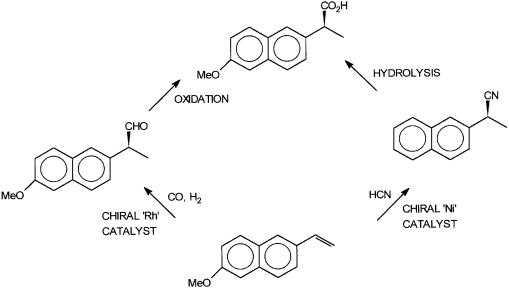
Figure 9.12 Two alternative synthetic routes for S-Naproxen. The left-hand route involves asymmetric hydroformylation, while the right-hand one uses asymmetric hydrocyanation.
219
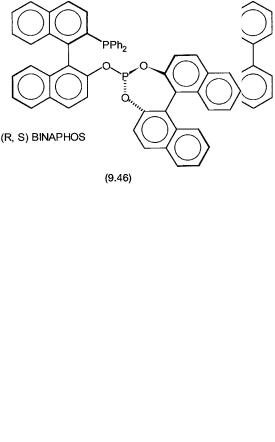
220 ASYMMETRIC CATALYSIS
The two metals that have been found to give encouraging conversions and selectivities for the hydroformylation of styrene are platinum and rhodium. The platinum-based catalytic system uses tin chloride as a promoter. It also uses triethyl orthoformate as a scavenger that reacts with the aldehyde to form the acetal. By removing it as soon as it is formed, any further degradative reactions of the aldehyde are avoided. The chirality in these reactions is induced by the use of optically active phosphorus ligands. With the best platinum catalyst, branched and linear aldehydes are produced in about equal proportion, but the former has an e.e. of >96%.
Until recently rhodium catalysts gave lower enantioselectivity, but higher chemoselectivity and activity, than the platinum-based catalysts. However, in the past few years rhodium complexes of a few chiral diphosphites and phosphinophosphito ligands have been reported. These complexes have excellent activities and high chemo-, regio-, and enantioselectivities.
The phosphite ligand 9.45 is derived from the chiral back-bone of 2,4-pen- tane diol while 9.46 is based on binapthol and is called (R,S) BINAPHOS. With the latter, under mild conditions high regioselectivity (>85%) and enantioselectivity (>95%) are obtained for a wide variety of styrene derivatives including the precursor for ibuprofen.
ASYMMETRIC CATALYTIC REACTIONS OF C–C BOND FORMATION |
221 |
9.5.2Mechanism of Asymmetric Hydroformylation Reaction
As we have seen in Chapter 5, the mechanistic details of the hydroformylation reaction with rhodium triphenylphosphine complexes are well established. These mechanistic considerations may be modified and extrapolated to the chiral hydroformylation system. One important point to bear in mind is that bidentate rather than monodentate ligands are involved in the chiral hydroformylation system.
A hypothetical catalytic cycle for asymmetric hydroformylation reaction is shown in Fig. 9.13. The precatalyst Rh(acac)(P-P) reacts with H2 and CO to give the square planar catalytic intermediate 9.47. Alkene addition to 9.47 can lead to the formation of 9.48, 9.49, and 9.50. The steric requirements of the chelating ligand would have to be such that the formation of 9.50 is avoided. This is because alkene insertion into the Rh–H bond in this case would lead to the formation of the linear rather than the branched alkyl. Both 9.48 and 9.49, which differ in the coordination positions of the phosphorus atoms, can give 9.51, which has the desired branched alkyl ligand.
Both regioselection and enantioselection are effected during the conversion of 9.48 or 9.49 to 9.51. The alkyl complex 9.51 undergoes the usual CO insertion followed by oxidative addition of dihydrogen, etc. (see Section 5.2.1) to give enantiomerically pure aldehyde product. Although in the catalytic cycle only one diastereomer for 9.48 and 9.49 has been shown, both these intermediates can have two diastereomers each. In these diastereomers the chirality of the chelating ligand is obviously the same, but coordination by the alkene takes place through the other enantioface.
Two alternative postulates for enantioselection may be proposed. In the first all four diastereomers are formed in varying amounts, and the relative amounts are determined by their respective thermodynamic stabilities. Assuming approximately equal amounts of each diastereomer to be present, if one of them has a transition state that is about 2.5 kcal lower in energy than the transition states of the others, more than 90% enantioselection for 9.51 would result. The proposed mechanism for enantioselection is thus similar to that of asymmetric hydrogenation (see Section 9.3.1). In the second postulate only one such diastereomer is produced; that is, the thermodynamic stability of one of the diastereomers is higher than that of the others. The stable diastereomer owing to its steric and electronic characteristics is converted to 9.51 in an enantioselective manner.
Either of the mechanisms postulated above is far from being well established. With 9.46 as a ligand, in the absence of alkene but in the presence of H2 and CO, a species such as 9.52 has been identified by NMR. This complex is sufficiently stable. No fluxional behavior is observed up to a temperature of 60 C.
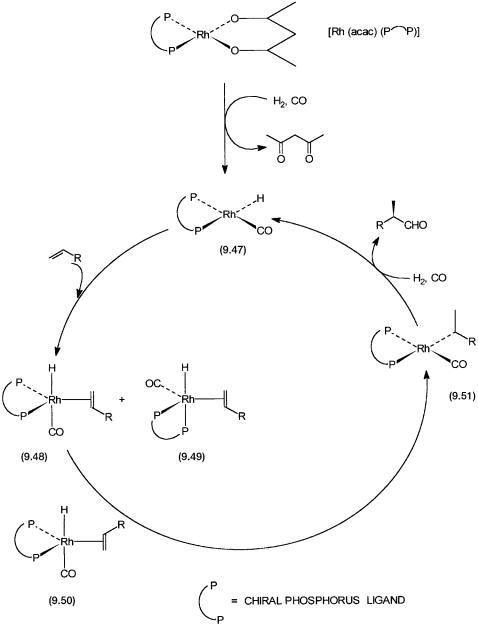
222 ASYMMETRIC CATALYSIS
Figure 9.13 Proposed catalytic cycle for asymmetric hydroformylation reaction with [Rh(acac)(P–P)] as the precatalyst. The chelating chiral phosphorus ligand could be 9.45 or 9.46. acac = acetylacetonato anion.
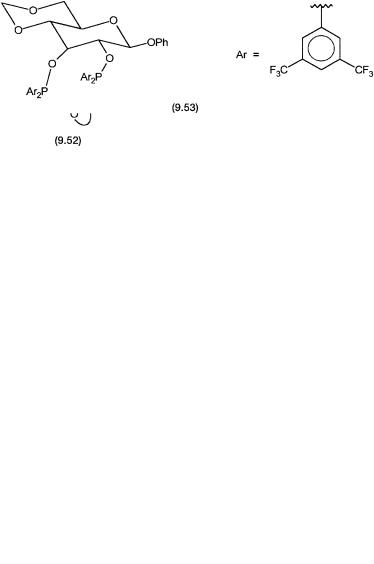
ASYMMETRIC CATALYTIC REACTIONS OF C–C BOND FORMATION |
223 |
Obviously the preferred coordination positions are the phosphite in the axial position and the phosphine in the equatorial position. This, however, is not the case with 9.45. Here NMR studies indicate the formation of a relatively stable isomer, where both the phosphorus atoms are in the equatorial positions as in 9.48. The evidence gathered so far seems to indicate that for both 9.45 and 9.46 only one stable diastereomer is formed. As proposed in the second postulate, this diastereomer probably determines the stereochemical course of the subsequent catalytic steps.
9.5.3Asymmetric Hydrocyanation Reaction
Successful development of the asymmetric hydrocyanation reaction may provide a versatile route to chiral nitriles, amines, and acids. As we have seen, the mechanistic details of the hydrocyanation reaction of butadiene with zerovalent nickel complexes are well established. By using a nickel complex of a chiral bidentate phosphinite ligand, 9.53, good conversion and enantioselectivity (>85% e.e.) for the hydrocyanation of 6-methoxy 2-vinyl naphthalene have been obtained.
The aromatic substituents on the phosphorus atoms have a pronounced effect on the enantioselectivity of this reaction. Instead of CF3 groups, if the aromatic rings are substituted in the same positions by CH3 groups, the e.e. value drops by 70%. This indicates that electronic factors may play a crucial role in the enantioselection mechanism. The proposed catalytic cycle for this reaction is shown in Fig. 9.14. All the steps shown in the catalytic cycle have precedence in achiral hydrocyanation reactions (see Section 7.7).
The precatalyst Ni(COD)2 reacts with 9.53 to give 9.54. This intermediate undergoes substitution of the remaining COD molecule by the substrate to give
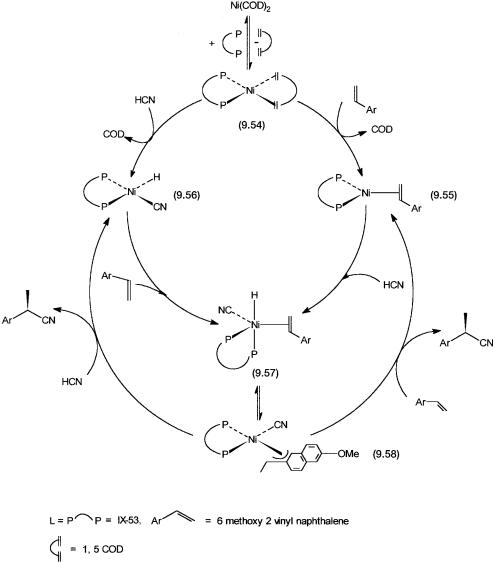
224 ASYMMETRIC CATALYSIS
Figure 9.14 Catalytic cycle for the asymmetric hydrocyanation of 6-methoxy-2-vinyl naphthalene with Ni(COD)2 as the precatalyst and 9.53 as the chiral ligand.
9.55. Oxidative addition of HCN onto 9.54 with the elimination of COD leads to the formation of 9.56. Oxidative addition by HCN and coordination by the substrate onto 9.55 and 9.56, respectively, lead to the formation of 9.57. Insertion of the alkene functionality into the Ni–H bond leads to the formation of the 3-allyl intermediate 9.58. Substrate addition or oxidative addition of

ASYMMETRIC CATALYTIC REACTIONS OF C–C BOND FORMATION |
225 |
HCN may accompany reductive elimination of the nitrile product from 9.58. In the former case 9.55 and in the latter 9.56 are regenerated to complete the catalytic cycle.
Kinetic analyses indicate that both the right-hand and the left-hand-side loops of the catalytic cycle are active. Of the two, which dominates would depend upon the relative concentrations of the substrate and HCN. Kinetic and deuterium-labeling studies also indicate all the steps from 9.54 to 9.57 to be reversible. The intermediate 9.55 has been identified by 31P NMR. Note that for 9.55 more than one diastereomer is possible, and indeed at room temperature these are found to be in rapid equilibrium with each other. Kinetic and spectroscopic evidence taken together suggests that enantioselectivity is determined in the insertion, 9.57 to 9.58, and/or in the reductive elimination, 9.58 to 9.55 or 9.56, steps.
9.5.4Nitroaldol Condensation
Asymmetric nitroaldol condensation, reaction 9.10, has been used to make an intermediate for the drug S-propanolol 9.61. The condensation reaction is catalyzed by the chiral heterobimetallic binaphthol complex 9.12 with high (>90%) enantioselectivity.
Complex 9.12 and its analogues, with other rare earth and alkali metals, have the unique combination of properties of both a Brønsted base and a Lewis acid. The Li–O bond (Brønsted base) abstracts a proton from nitromethane. At the same time coordination of the carbonyl oxygen atom to La3 (Lewis acid) activates the carbonyl group. The formulations for 9.12 and its analogues were first established by a sophisticated mass-spectrometric technique called laserdesorption/ionization time-of-flight (LDI-TOF) mass spectrometry. The molecular structures of several such complexes have subsequently been established by single-crystal X-ray studies.
